Josh Zurcher (left) and Andrew Montijo fine tune their senior class project, an autonomous car able to traverse the Cal campus.
A small self-driving vehicle rolls across the California campus, navigating walkways and turns with precision, all while collecting and analyzing data. For Joshua Zurcher and Andrew Montijo, this seemingly simple trip is the culmination of their senior project at PennWest University.
As graduating seniors in the Electrical Engineering Technology program, Zurcher and Montijo teamed up to develop an autonomous vehicle, using their knowledge of computer science, math, physics, and electrical engineering.
“Our goal was to create an autonomous system that can demonstrate the capabilities of RTK (real time kinematics) GPS, and how precise it can be.” said Zurcher, from Youngstown, Ohio.
Utilizing cutting edge RTK-GPS for centimeter-level positioning, the vehicle also uses forward-looking LIDARs fused with ultrasonic proximity sensors for a comprehensive view of potential obstacles. This sensor fusion enables active collision avoidance by enabling the vehicle to detect obstacles and pedestrians while it navigates. An HTML web interface also allows remote selection of a destination.
“This project has been an incredible experience,” said Montijo, of Connellsville, Pennsylvania. “We managed to integrate theory with hands-on application, and it’s exciting to see our project come together.”
The vehicle, built from a modified RC car, has a variety of components installed, including a new motor, steering servo, LIDAR and ultrasonic sensors, RTK-GPS receiver, and a LoRa® transceiver, all powered by a custom PCB, or printed circuit board, designed by the duo.
“We needed a way to power everything, so we decided to design and build a custom power distribution PCB for the vehicle.” Montijo said. “This PCB receives a higher voltage, steps it down, then distributes it to all of the vehicle’s components.”
However, developing a fully autonomous vehicle wasn’t easy. Zurcher and Montijo faced technical challenges integrating the components. To get the most accurate precision, they had to build a reference station to ensure precise location data. This “differential GNSS” reference station generates the correction signals which help the vehicle calculate its exact location, providing the necessary accuracy for safe navigation.
“One of the most difficult challenges was making sure the system could interpret all the data and respond accordingly,” Zurcher said.
To overcome these hurdles, Zurcher and Montijo leaned on their expertise in electronics and robotics, with Zurcher’s background as an avionic electronic warfare technician in the Marine Corps proving invaluable. The duo spent months testing and refining their vehicle’s software to ensure it could perform reliably.
Despite these challenges, their vehicle now successfully navigates the campus environment, making decisions and adjusting speeds.
Dr. Fanourios Halkiadakis, who teaches the 2-semester senior project course and advised students on their senior projects, praised the students’ dedication. “There were a lot of electrical and computer engineering technology aspects involved in this project,” he said. “Anyone who studies the detailed report of this project will understand how complicated it is. The students have put in a lot of hours. I give them a lot of credit.”
Looking ahead, Zurcher and Montijo are focused on further optimizing their technology, improving the vehicle’s decision-making algorithms, and enhancing its performance.
